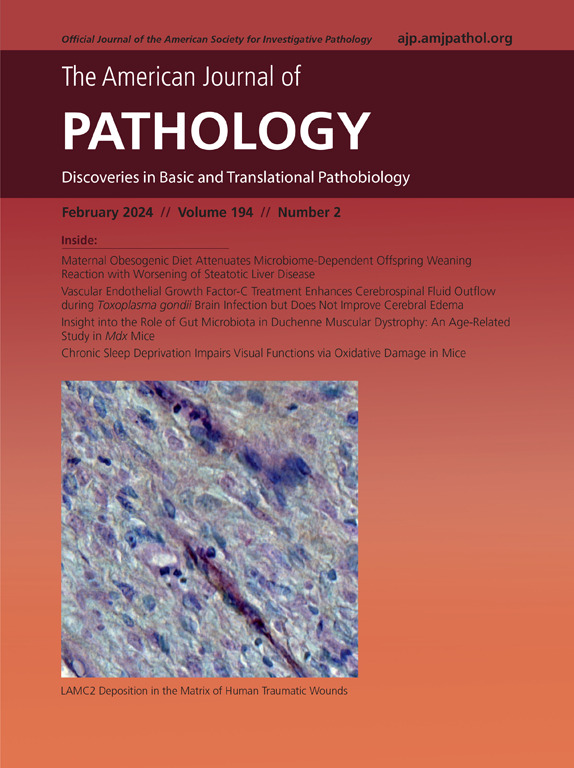A Recognition System for Diagnosing Salivary Gland Neoplasms Based on Vision Transformer
IF 4.7
2区 医学
Q1 PATHOLOGY
引用次数: 0
Abstract
Salivary gland neoplasms (SGNs) represent a group of human neoplasms characterized by a remarkable cytomorphologic diversity, which frequently poses diagnostic challenges. Accurate histologic categorization of salivary gland tumors is crucial to make precise diagnoses and guide decisions regarding patient management. Within the scope of this study, a computer-aided diagnosis model using Vision Transformer (ViT), a cutting-edge deep learning model in computer vision, was developed to accurately classify the most prevalent subtypes of SGNs. These subtypes include pleomorphic adenoma, myoepithelioma, Warthin tumor, basal cell adenoma, oncocytic adenoma, cystadenoma, mucoepidermoid carcinoma, and salivary adenoid cystic carcinoma. The data set comprised 3046 whole slide images of histologically confirmed salivary gland tumors, encompassing nine distinct tissue categories. SGN-ViT exhibited impressive performance in classifying the eight salivary gland tumors, achieving an accuracy of 0.9966, an area under the receiver operating characteristic curve value of 0.9899, precision of 0.9848, recall of 0.9848, and an F1 score of 0.9848. Diagnostic performance of SGN-ViT surpassed that of benchmark models. In a subset of 100 whole slide images, SGN-ViT demonstrated comparable diagnostic performance to that of the chief pathologist while significantly reducing the diagnosis time. These observations indicate that SGN-ViT holds the potential to serve as a valuable computer-aided diagnostic tool for salivary gland tumors, enhancing the diagnostic accuracy of junior pathologists.
基于视觉变换器的唾液腺肿瘤诊断识别系统
唾液腺肿瘤(SGNs)是一组人类肿瘤,其特点是具有显著的细胞形态多样性,这经常给诊断带来挑战。对唾液腺肿瘤进行准确的组织学分类对于做出精确诊断和指导患者管理决策至关重要。在本研究范围内,利用计算机视觉领域最前沿的深度学习模型Vision Transformer开发了一种计算机辅助诊断模型,可对最常见的唾液腺肿瘤亚型进行准确分类。这些亚型包括多形性腺瘤、肌上皮瘤、Warthin瘤、基底细胞腺瘤、肿瘤细胞腺瘤、囊腺瘤、粘液表皮样癌和唾液腺样囊性癌。数据集包括 3046 张经组织学确诊的唾液腺肿瘤全切片图像(WSI),涵盖九个不同的组织类别。SGN-ViT 在对八种唾液腺肿瘤进行分类时表现出令人印象深刻的性能,准确率达到 0.9966,AUC 值达到 0.9899,精确度达到 0.9848,召回率达到 0.9848,F1 分数达到 0.9848。与基准模型相比,SGN-ViT 的诊断性能更胜一筹。在 100 个 WSI 子集中,SGN-ViT 的诊断性能与首席病理学家的诊断性能相当,同时大大缩短了诊断时间,这表明 SGN-ViT 有潜力成为唾液腺肿瘤的重要计算机辅助诊断工具,提高初级病理学家的诊断准确性。
本文章由计算机程序翻译,如有差异,请以英文原文为准。
求助全文
约1分钟内获得全文
求助全文
来源期刊
CiteScore
11.40
自引率
0.00%
发文量
178
审稿时长
30 days
期刊介绍:
The American Journal of Pathology, official journal of the American Society for Investigative Pathology, published by Elsevier, Inc., seeks high-quality original research reports, reviews, and commentaries related to the molecular and cellular basis of disease. The editors will consider basic, translational, and clinical investigations that directly address mechanisms of pathogenesis or provide a foundation for future mechanistic inquiries. Examples of such foundational investigations include data mining, identification of biomarkers, molecular pathology, and discovery research. Foundational studies that incorporate deep learning and artificial intelligence are also welcome. High priority is given to studies of human disease and relevant experimental models using molecular, cellular, and organismal approaches.

 求助内容:
求助内容: 应助结果提醒方式:
应助结果提醒方式:


